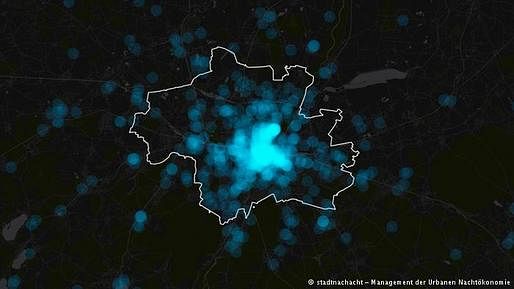

When I speak with a student about nightlife they have something different in mind than a 65-year old town planning manager. In the municipalities, finding contacts is difficult - often nobody feels responsible or capable of speaking. That should change. — DW.de
There are sleepy cities and cities that never sleep. There are cities famed for their raucous nightlife, and others whose adolescent residents dream of leaving. According to the German urban scientist Jakob F. Schmid, interviewed for DW.DE, "Nightlife often defines the character of entire streets or districts." Schmid runs the "City After Eight - Management of the Urban Night Economy" project with Thomas Krüger, which is funded by the German government.

Looking at a variety of German cities including Berlin, Hamburg, and Frankfurt, the researchers mapped nightlife "with online recommendation platforms as the basis for the data." The hazy blue results indicate that various forms a city's nightlife may take. In the famed-party city Berlin, for example, hotspots are diffused throughout the expansive metropolis. In a traditional German city, on the other hand, the nightlife tends to be concentrated "on the city center, usually on the streets directly surrounding the center proper."
In the interview, Schmid notes that such knowledge of the city's nocturnal existence is vital for urban planners and policy-makers. For certain cities or districts, nightlife tourism is a large source of revenue. In other places, loud clubs are a blight and source of noise-pollution. Regardless, knowledge is pivotal for the improvement of cities although, as Schmid notes, in the case of nightlife, sometimes inaction (on the part of planners) is the best action of all.


No Comments
Block this user
Are you sure you want to block this user and hide all related comments throughout the site?
Archinect
This is your first comment on Archinect. Your comment will be visible once approved.